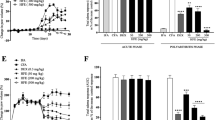Abstract
Freund's adjuvant arthritis (FAA) in susceptible rats (male, Lewis strain) is a well-established experimental model of rheumatoid arthritis to evaluate inherent drug properties, i.e. anti-inflammatory and/or immunosuppressive/immunomodulatory properties which are only ascertained by combining multiple parameter analysis. We employed a synoptic multiparametric evaluation system for the multifaceted FAA, a so-called “spider scheme”, to facilitate a more rapid and easier comparison of qualitative and quantitative drug properties by visual display than that achieved by mere tabulation of the data. The spider scheme comprised six well-established parameters to evaluate the FAA disease (primary and secondary hind paw swelling, arthritic index which included macroscopic alterations of non-injected paws, nose, ears and tail, body weight changes and relative organ weights of thymus and spleen). By calculation of an index as a percent change in comparison to control and untreated diseased animals, the degree of improvement or impairment of the FAA by a tested compound could easily be entered into the spider scheme.
The FAA parameter spider scheme clearly differentiated the most beneficial immunomodulatory properties of cyclo-sporin A from those of the immunosuppressive agents dexamethasone and cyclophosphamide as well as from the mere anti-inflammatory cyclooxygenase inhibitors. Among this latter class of non-steroidal anti-inflammatory compounds, a similar profile was demonstrated for indometacin and diclofenac, as well as for tenidap, which is claimed to have cytokine-modulating properties, as reflected by the reduction of acute-phase proteins in patients with rheumatoid arthritis. Yet, in this FAA model, with tenidap, no additional qualitative drug properties could be discerned. Quantitative improvement of certain parameters by indometacin was easily differentiated from unchanged disease parameters.
Thus, the complex set of pharmacological data provided by the rat FAA model was visually displayed by the multiparameter spider scheme, allowing a more rapid and easier comprehension of antirheumatic drug profiles.
Similar content being viewed by others
References
J. Holoshitz, A. Matitiau and I. R. Cohen,Arthritis induced in rats by cloned T lymphocytes responsive to mycobacteria but not to collagen type II. J. Clin. Invest.73, 211–215 (1984).
M. E. J. Billingham,Models of arthritis and the search for anti-arthritic drugs. Pharmacol. Ther.21, 389–428 (1983).
P. Theisen-Popp, H. Pape and R. Müller-Peddinghaus,Interleukin-6 (IL-6) in adjuvant arthritis of rats and its pharmacological modulation. Int. J. Immunopharmacol.14, 565–571 (1992).
M. J. Dimartino, J. C. Lee, A. M. Badger, K. A. Muirhead, C. K. Mirabelli and N. Hanna, Antiarthritic and immunoregulatory activity of spirogermanium. J. Pharmacol. Exp. Ther.236, 103–110 (1986).
K. R. Gans, W. Galbraith, R. J. Roman, S. B. Haber, J. S. Kerr, W. K. Schmidt, C. Smith, W. E. Hewes and N. R. Ackerman, Anti-inflammatory and safety profile of DuP 697, a novel orally effective prostaglandin synthesis inhibitor. J. Pharmacol. Exp. Ther.254, 180–187 (1990).
I. G. Otterness, T. J. Carty and L. D. Loose,Tenidap: A new drug for arthritis. InTherapeutic Approaches to Inflammatory diseases. (Eds. A. J. Lewis, N. S. Doherty and N. R. Ackerman) pp. 229–241, Elsevier, Amsterdam 1989.
I. G. Otterness, P. P. Pazoles, P. F. Moore and M. B. Pepys,C-reactive protein as an index of disease activity. Comparison of tenidap, cyclophosphamide and dexamethasone in rat adjuvant arthritis. J. Rheumatol.18, 505–511 (1991).
L. D. Loose, B. H. Littman and J. D. Sipe,Modulation of acute phase proteins by tenidap, a new anti-inflammatory, antirheumatic drug. Clin. Res.38, 579A (1990).
P. Katz, A. P. Borger and L. D. Loose,Evaluation of CP-66, 248 [5-chloro-2,3-dihydro-2-oxo-3-(2-thienyl-carbonyl)-indole-1-carboxamide] in rheumatoid arthritis (RA). Arthritis Rheum.31 (4, Suppl.), A87 (1988).
J. D. Sipe, L. M. Bartle and L. D. Loose,Modification of proinflammatory cytokine production by the antirheumatic agents tenidap and naproxen. A possible correlate with clinical acute phase response. J. Immunol.148, 480–484 (1992).
K. M. Connolly, V. J. Stecher, T. Labrie and C. Fluno,Modulation of the acute phase response and in vitro measurement of interleukin-1 activity following administration of dexamethasone to adjuvant-arthritic rats. Immunopharmacology15, 133–142 (1988).
L. Fesus,Biochemical events in naturally occurring forms of cell death. FEBS Lett.328, 1–5 (1993).
I. Otterness and D. Gans,Nonsteroidal anti-inflammatory drugs: An analysis of the relationship between laboratory animal and clinical doses, including species scaling. Pharmacol. Sci.77, 790–795 (1988).
T. Hirano, S. Akira, T. Taga and T. Kishimoto,Biological and clinical aspects of interleukin 6: Immunol. Today11, 443–449 (1990).
D. E. Hatzigeorgiou, S. He, J. Sobel, K. H. Grabstein, A. Hafner and J. L. Ho,IL-6 down-modulates the cytokine-enhanced antileishmanial activity in human macrophages. J. Immunol.151, 3682–3692 (1993).
A. C. Allison and S. W. Lee,The mode of action of anti-rheumatic drugs. 1. Anti-inflammatory and immunosuppressive effects of glucocorticoids. Progr. Drug. Res.33, 63–81 (1989).
L. M. Breuninger, W. L. Dempsey, J. Uhl and D. M. Murasko,Hydrocortisone regulation of interleukin-6 protein production by a purified population of human peripheral blood monocytes. Clin. Immunol. Immunopathol.69, 205–214 (1993).
A. W. Thomson, P. H. Whiting and J. G. Simpson,Cyclosporine: Immunology, toxicity and pharmacology in experimental animals. Agents and Actions15, 306–327 (1984).
J. F. Borel, H. U. Gubler, P. C. Hiestand and R. M. Wenger,Immunopharmacological properties of cyclosporine (Sandimmune®) and (Val 2)-dihydrocyclosporine and their prospect in chronic inflammation. InTherapeutic control of inflammatory diseases new approaches to antirheumatic drugs. (Eds. I. Otterness, A. Lewis and R. Capetola) Raven Press, New York; Adv. Inflamm. Res.11, 277–291 (1986).
K. M. Connolly, V. J. Stecher, E. Danis, D. J. Pruden and T. Labrie,Alteration of interleukin-1 production and the acute phase response following medication of adjuvant arthritic rats with cyclosporin-A or methotrexate. Int. J. Immunopharmacol.10, 717–728 (1988).
E. del Pozo, M. Graeber, P. Elford and T. Payne,Regression of bone and cartilage loss in adjuvant arthritic rats after treatment with cyclosporin A. Arth. Rheum.33, 247–252 (1990).
D. Faulds, K. L. Goa and P. Benfield,Cyclosporin. A review of its pharmacodynamic and pharmacokinetic properties, and therapeutic use in immunoregulatory disorders. Drugs45, 953–1040 (1993).
Author information
Authors and Affiliations
Rights and permissions
About this article
Cite this article
Theisen-Popp, P., Müller-Peddinghaus, R. Antirheumatic drug profiles evaluated in the adjuvant arthritis of rats by multiparameter analysis. Agents and Actions 42, 50–55 (1994). https://doi.org/10.1007/BF02014300
Received:
Accepted:
Issue Date:
DOI: https://doi.org/10.1007/BF02014300




